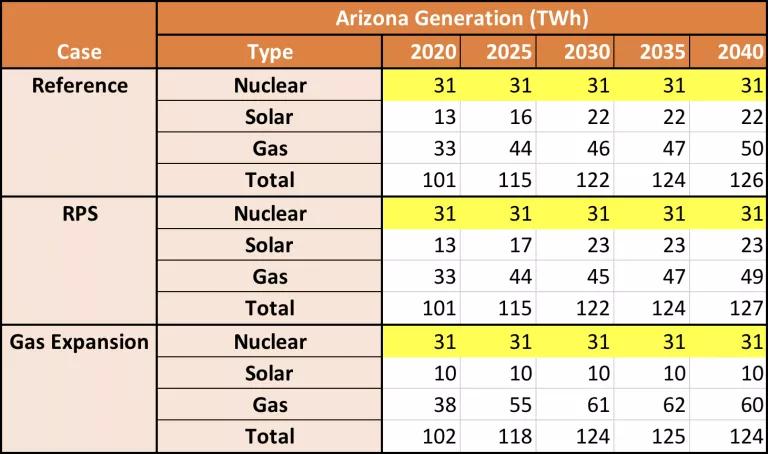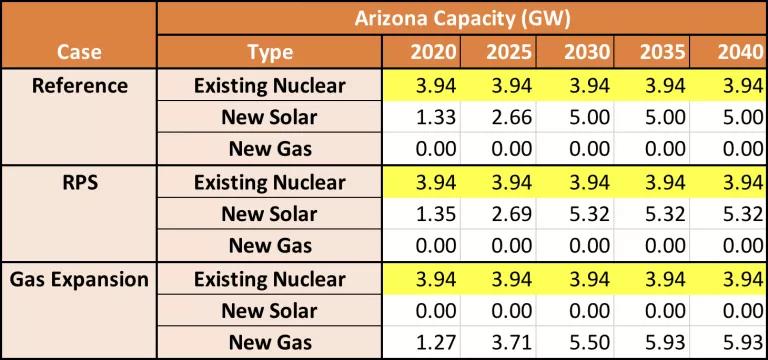
New power sector modeling, conducted by renowned energy firm ICF, using assumptions based on publicly-available information developed by the Natural Resources Defense Council (NRDC), finds that Arizona’s Palo Verde nuclear power plant stays open and operates around-the-clock, even as utilities build enough renewable energy capacity, like wind and solar farms, to meet a 50 percent by 2030 renewable portfolio standard (RPS).
The new study is consistent with other analyses from financial firms and the U.S. government, which have found that Palo Verde can continue to operate and make money for its owners, even when other nuclear power plants in the U.S. face financial difficulty.
But these results are contrary to rhetoric from Arizona Public Service (APS), the state’s largest utility, which owns 29.1 percent of the plant and operates it for a consortium of Southwest utilities. Searching for arguments against the Clean Energy for a Healthy Arizona initiative, which would require Arizona utilities like APS and Tucson Electric Power (TEP) to meet stronger renewable energy goals, APS has claimed the initiative would force it to close Palo Verde, but has never shown how it reaches this conclusion.
Actual analysis shows that the Western grid can reliably manage much larger amounts of renewable power while keeping Palo Verde open. As the largest nuclear power plant in the U.S., Palo Verde has economies of scale that allow it to remain competitive even in a future with low-cost renewables and gas power, and wholesale power prices in the west are higher than in most of the rest of the country.
Below we discuss the model ICF used, the assumptions we developed, and the results. We also summarize other analyses about Palo Verde’s viability.
But first, some introductions
NRDC is a national not-for-profit organization with around 9,000 members in Arizona. We frequently use power sector modeling to understand the costs and benefits of different policy proposals. NRDC’s analysis of a 50 percent RPS in Arizona was performed by energy consultancy ICF, using their Integrated Planning Model (IPM®), and assumptions developed by NRDC. IPM is a detailed model of the electric power system that is routinely used by the electricity industry and regulators, including the U.S. Environmental Protection Agency, to assess the effects of environmental regulations and policy. It integrates extensive information on power capacity and generation, technology performance, transmission, energy demand, electricity and fuel prices, policies, and other factors. IPM then determines the most cost-effective way to meet electricity needs, based on its detailed representation of the U.S. electricity system. It can build new power plants, retire existing plants, or ramp them up and down to meet demand in the least-cost way.
Our scenarios, inputs, and assumptions
ICF ran the model with two different policy cases based on NRDC’s assumptions: an RPS case and a Gas Expansion case.
For the RPS case, utilities subject to Arizona’s existing 15 percent by 2025 Renewable Energy Standard—basically all utilities except Salt River Project—have to meet a 50 percent renewable energy by 2030 target, with interim benchmarks along the way. This matches the Clean Energy for a Healthy Arizona proposed ballot measure for the November 2018 general election ballot.
In the Gas Expansion case, APS and TEP meet current and future energy needs, in part, by building 5,900 MW of gas-fired power plants. This matches the long-term resource plans the state’s utilities submitted to the Arizona Corporation Commission (ACC).
Assumptions for this analysis were developed by NRDC, relying primarily on publicly available projections from various parts of the U.S. Department of Energy (DOE). For gas prices and energy demand, we relied on reference case (“business as usual”) projections from the Energy Information Administration (EIA), which is an independent statistical agency of the DOE. For power plant costs, we relied on the EIA for the costs of building new fossil fuel-fired generation or new nuclear plants, and the DOE’s National Renewable Energy Laboratory (NREL) Annual Technology Baseline projections for the costs of building new wind and solar projects, which represent its expert view on the future costs of renewable technologies. Additionally, limits on variable renewable generation were incorporated to approximate the amount of solar and wind the grid can accommodate without additional transmission investments.
Results
Two important results emerge from the model’s “generation mix” results.
- Palo Verde stays open in all cases. The choice Arizonans face in November is whether to power their future with renewable energy or with carbon-emitting gas. The continued operation of Palo Verde is not threatened by a 50 percent RPS. Why is the model not ramping down or shutting off Palo Verde? From an economic perspective, adding low-cost solar to regional power mix displaces higher-cost coal and gas electricity, not Palo Verde, which is fairly cheap to operate. From a grid-operator perspective, It’s likely that electricity demand in Arizona is sufficient to soak up Palo Verde’s generation, and the output of extra solar, on all but a few days in the spring and fall. On those few days, solar and nuclear can be exported throughout the 13-state Western Interconnection. This highlights something discussed later in the blog: APS and Arizona should be at the forefront of efforts to integrate the operation of the Western electric grid. This would make it easier for, say, Arizona and its utilities to sell and transmit solar and nuclear power to other customers in the Pacific Northwest or Southern California.
- The generation mix that emerges from the RPS case is remarkably similar to the mix the model projects under a Reference case scenario, where only policies and capacity changes already approved are modelled. In other words, the clean energy future encouraged by the 50 percent RPS looks almost exactly like the model’s cost-optimized electricity future for the state, the mix an all-knowing economist would choose for the state if there were no 50 percent RPS, APS, or ACC.
These two key results are highlighted in the table below. The table shows the amount of electricity generated by Arizona solar, gas, and nuclear plants, and total generation, under three cases: the Reference case and the two policy scenarios. Note that the nuclear generation is the same in all three cases. And in the Reference and RPS cases, total generation is higher than in the gas-heavy case (meaning more of the state’s energy demand is met with local resources), because solar power more-than-doubles. By 2030, there is enough solar in both the reference and RPS cases to power around 1.8 million Arizona households from clean, local solar energy annually.

The second table is power plant capacity: the instantaneous power production capacity of power power plants of a given type in Arizona in a given year. Nuclear capacity does not change across the three cases, and the nuclear operates essentially around-the-clock, at a capacity factor of 90 percent.

U.S. Government and financial firms predict Palo Verde will remain open
Because of its importance to the Western electricity grid—it is the biggest power plant by annual electricity output in the U.S. and the second in size—other analysts have also examined Palo Verde’s viability in a future with lots of low-cost renewable energy and gas power (low gas prices have had a much bigger impact on the viability of baseload resources than renewables in the last few years). Below we summarize three recent analyses.
Energy Information Administration
EIA, the statistical agency of the US Department of Energy, annually conducts a comprehensive forecast of the U.S. energy system, the Annual Energy Outlook. This year, as part of the AEO, they conducted a detailed analysis of the U.S. nuclear fleet, testing nuclear power plants’ sensitivity to gas prices (which directly affect the price of nuclear’s key competitor, gas-fired power plants, and directly affect wholesale power prices), environmental regulation (carbon taxes make nuclear more competitive), and upkeep and maintenance costs of nuclear plants themselves. Even in their toughest case for nuclear, where plant maintenance costs increase 20 percent and gas prices plummet, where nationwide, over 80 percent of all nuclear capacity shuts down by 2050, Palo Verde stays open.
The EIA found that smaller, single unit nuclear power plants that operate in deregulated markets are more sensitive to low wholesale power prices than big plants in regulated markets. Palo Verde is the nation’s biggest nuclear plant, and only one owner, Southern California Edison, with a 15.8 percent share, operates in a quasi-deregulated market. EIA notes that large plants can spread fixed overhead costs over a large base of generation, and that they can take advantages of economies of scale when negotiating service and fuel contracts.
Bloomberg New Energy Finance
Bloomberg New Energy Finance has estimated the profits for every nuclear power plant in the U.S., in an analysis described here. In the underlying report, BNEF found that Palo Verde will continue produce about $60 million per-year in profit for its owners in the near-future. This analysis also only considers energy market revenue: the value of the plant’s capacity, which any regulator would take into account when weighing whether or not the plant should close, could be worth another $150-300 million per-year.
National Renewable Energy Laboratory
In addition to the two economic analyses above, the National Renewable Energy Laboratory (NREL), as part of a years-long modeling effort that “explores the implications and challenges of very high renewable electricity generation levels,” studied how the Western grid, operationally, could accomodate 80 to 90 percent renewable energy. In their scenarios, more than seven gigawatts of always-on nuclear resources continue to operate in the West, including Palo Verde’s four gigawatts.
The authors conclude that, operationally, the Western grid can operate reliably with 80 to 90 percent renewables, and that new, flexible options like energy storage and demand response can help integrate more renewables and mitigate curtailment — when grid operators turn down wind and solar when they cannot be used. They also find that integration of the West’s balkanized grid is important, and that Arizona’s ability to export electricity to big electricity load centers in Southern California is limited by a lack of transmission capacity. In total, the study shows that integrating very high levels of renewables is possible, even as nuclear plants like Palo Verde stay open. (For NRDC's general view on the role of nuclear in a deeply-decarbonized world see my colleague Matthew McKinzie's blog.)
Aside from its PR effort, APS is not acting like the plant is at risk
If APS were actually concerned about the long-term viability of Palo Verde in a high-renewables future, we would see it in actions, not just an all-out PR effort. APS would be aggressively adding new, flexible power options like demand response and energy storage, instead of limiting storage and doubling-down on gas power. APS would be building more transmission capacity between Arizona and big electricity load centers in Southern California. APS would also be pushing for integration of the Western grid’s 37 separate fiefdoms, which currently make it much more difficult for owners of cheap, clean power plants, like solar in Arizona or Palo Verde, to sell electricity across the grid’s institutional boundaries.
But APS is not doing these things, and that, combined with ample evidence that Palo Verde is actually viable in a high-renewables future, suggests APS is not actually worried. Instead, they are just trying to stop a ballot initiative they dislike.

